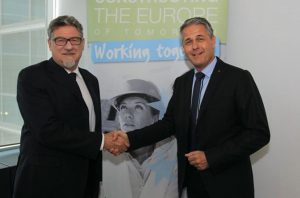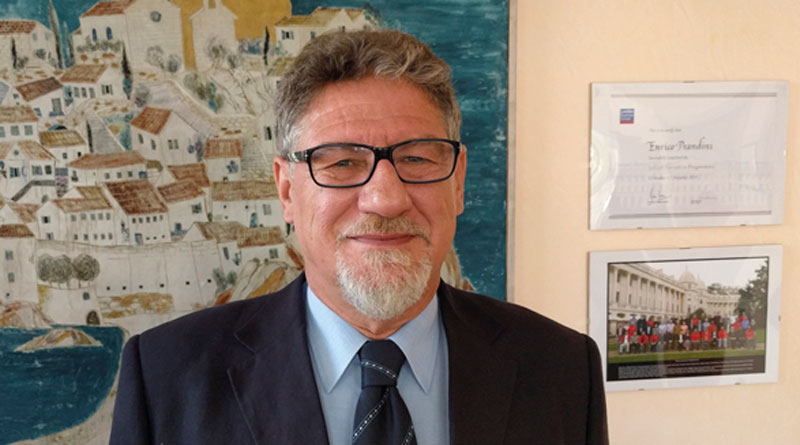At Work to Build a Common Vision
Increased recognition from the political class, the setting up of a “common vision” with the end client, improved communication skills, digitalization in the value chain: these are the pillars on which Enrico Prandini’s strategy is built having been elected President of CECE, the Committee for European Construction Equipment, in January.
 On the 1st of January 2018, Enrico Prandini began his new role as President of CECE, the Committee for European Construction Equipment. Having already been vice-president of the European federation, Prandini takes the reigns from Bernd Holz.
On the 1st of January 2018, Enrico Prandini began his new role as President of CECE, the Committee for European Construction Equipment. Having already been vice-president of the European federation, Prandini takes the reigns from Bernd Holz.
Enrico Prandini is CEO of Komatsu Italy Manufacturing and vice-president of UNACEA, the Italian construction machinery association. In the Komatsu Italy Manufacturing HQ in Este, near Padua, the “ASSIOT and ASSOFLUID meets” event was organized on February 20th. All those present were able to appreciate the impressive numbers coming out of the “Construction Equipment” sector. As CECE president, Enrico Prandini is now representing 1.200 European producers of construction machinery, with combined annual revenues of over €40bn and a workforce of 300.000 people.
InMotion met up with him to better understand the bedrock of his strategy and to talk about product loyalty, digitalization, standardization and lots more besides…
You were elected CECE president on the 1st of January. What can we expect from your mandate?
First and foremost, I will be pushing for greater political recognition of construction machinery manufacture, then focusing on the single European market and the creation of simple and effective regulations for all. We will invest heavily in communication and institutional relations, both at European political level and with the organizations active around Europe involved in promoting the sector. We want to boost the conversation with industrial representatives sharing our vision of the value chain. In this respect, we have organized a seminar on Digital Construction for the 22nd of February, within the context of the EU Industry Day 2018. Collaboration with the construction sector has been lacking in the past, so this will be a focus of my presidency. On top of this, we will be taking advantage of the many trade fairs coming up over the next two years like Intermat and Bauma, to promote our Committee. Speaking of which, CECE will be glad to welcome visitors to our stand at Intermat in Paris from the 23rd to the 28th April.
The next CECE congress, in Rome in October, will focus on gaining customer loyalty. Indeed, its title is “Customer loyalty through a common vision”. How important is this aspect in the construction machinery sector?
It is simply fundamental. We manufacture to satisfy clients, and the real challenge is that of understanding needs and finding solutions to problems before they become such.
This simply means being pro-active, investing in research and development, welcoming the client’s viewpoint as our corner stone. In this way, the customer becomes
a part of the production process and, in line with the recently published McKinsey report for CECE, focus is shifting, as must be the case, from operations that machinery can carry out to the satisfaction of a client’s needs.
Digitalization is becoming a driver in the sector and will soon involve the entire value chain. Under such circumstances, skills and roles of operators will evolve… on the other hand, there are also risks to be faced, above all concerning data security. How can companies protect themselves?
Digitalization is a great opportunity for our sector. Companies able to adapt to these changes will be those dominating the market, facing challenges with a dynamic approach. It is clear that such an approach will also run certain risks in terms of security, but a lot is being done to develop software and technology able to fight against possible attack. What we already know is that digitalization means gains in productivity, site safety, cuts in environmental damage – three key points for our sector and the entire commodity chain. This will clearly lead to an evolution in the way the operator works. Their first target will be to stay updated in terms of skill sets and technological knowledge. This will be another case for co-operation between associations and construction companies, whose employees will require regular training. This will also be central to the discussion in Rome, but I don’t want to give too much away, it is better to be there in person!
 How important is it to create an EU wide digital network as a standard to increase data fluidity across EU member states?
How important is it to create an EU wide digital network as a standard to increase data fluidity across EU member states?
Working on standardization, both in terms of digital and legislative systems, is essential. Without common reference points, the market is inevitably fragmented and risks not being globally competitive as well as failing client’s needs. The sharing of experience is also a crucial aspect in my opinion in organizing a truly European profile and creating the technological conditions necessary for the market. This means creating a united strategy, in which research and development can flourish and in which legislative infrastructure exists opening the potential of the single digital market to all players. The most recent CECE working group was entirely dedicated to the question of European Big Data regulation.
In the context of the single market, what is your strategy for increasing the sector’s political profile?
We need to focus political attention on certain crucial areas, which, despite the free movement of goods, are creating obstacles. This will be carried out through a communication campaign. The best example is that of legislative fragmentation, which, having created a variety of standards, impedes fluid flow of goods not only with extra EU countries, but even inside the EU itself. Another key battle will concern the inclusion of construction machinery in e-privacy regulation, which, in its first version, put such machinery in the same bracket as computers and smartphones, giving manufacturers the same obligations as mobile operators. The result for our sector could be disastrous, making the digital transformation a burden rather than the dawn of maximized efficiency and productivity. This may be difficult for those not working in our sector to understand and this is exactly why we are working so hard to make our position heard. To carry weight, it is necessary to invest in relationships and communication: only by using the right tools, can you make yourself understood, the key to getting good results.

